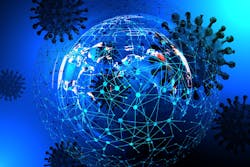Crystal IS and the Boston University (BU) National Emerging Infectious Diseases Laboratories (NEIDL) have announced research relative to ultraviolet (UV) LEDs operating in the UV-C band (100–280 nm) deactivating the SARS-CoV-2 virus. The work revealed almost instantaneous deactivation at wavelengths of 270 nm or shorter and much lower efficacy for LEDs operating at 280 nm.
While many have thought the ideal germicidal UV wavelength is 254 nm, that prevailing wisdom was simply based on the fact that mercury discharge lamps operated at that peak wavelength. Meanwhile, in the UV-C LED sector, longer wavelengths result in somewhat improved performance in terms of radiometric output and lifetime, and also somewhat reduced cost. Indeed, we are pursuing a feature article that will focus on tradeoffs in wavelength, UV-LED output power, and germicidal efficacy.
We have written previously that recent research (conducted once UV-C LEDs were widely available) may find that energy in the 265-nm range might actually have the greatest germicidal efficacy. UV LED manufacturer Crystal IS has now worked with BU’s NEIDL to test the efficacy specifically with the SARS-CoV-2 virus across the range of 260–270 nm where Crystal IS offers UV-C LEDs, and at 280 nm.
In general, the research confirms that proper UV-C doses can deactivate the virus that causes COVID-9 in a matter of a few seconds at worst. Documentation of such efficacy is expressed as a log reduction in active virus where 1 log efficacy would equate to 90% deactivation of virus, 2 log 99%, 3 log 99.9% and so on. The researchers exposed a surface with SARS-CoV-2 present to different doses of UV-C energy measured in units of mJ/cm2. That dosage metric encompasses the exposure duration and radiometric power in mW/cm2, although the researchers separately mentioned exposure duration explicitly to make the point on deactivation time.
In separate tests with 260-, 268-, and 270-nm LEDs, 4-sec exposure delivered efficacy of 2.6 log (260 nm), 2.8 log (268 nm), and 2.8 log (270 nm). That reference dosage was 5 mJ/cm2. The researchers also tested the 268-nm LED at lower dosages of 1.25 mJ/cm2, 2.5 mJ/cm2, and 3.75 mJ/cm2 achieving 0.7, 1.2, and 1.5 log performance.
Meanwhile, some LED manufacturers are promoting 280-nm LEDs for use in fighting SARS-CoV-2 because such LEDs can be manufactured more easily. Indeed, irradiance at that bandwidth will deactivate the virus. But efficacy does drop significantly at the longer wavelength. At 3.75 mJ/cm2, the 280-nm LEDs only delivered 0.9 log efficacy and it required a 37-mJ/cm2 dose to deliver 3 log efficacy.
This entire concept of germicidal efficacy relative to UV-C LEDs and also application methodology is going to require much more research and also coverage on our part. Just last week, we reported on a GE Current product that will operate at very low doses so that it can be safely used in the presence of people. That product might take a few hours to deactivate SARS-CoV-2, yet it could be operated continuously.
There have also been questions about whether UV-C LEDs are ready for SARS-CoV-2 duty because mercury lamps can generate far higher levels of irradiance and therefore higher efficacy. But only UV-C LEDs could be used in an application such as the Current product is intended. Moreover, we recently covered a product from Energy Harness intended to circulate and disinfect air that effectively uses LED sources.
Crystal IS has in fact long argued that product developers need to think about using UV-C LEDs in different scenarios from how mercury lamps are used. Those lamps must be powered on continuously even if the germicidal usage isn’t continuous. Warm-up times and failure due to frequent on-off cycles lead to the need for continuous power. However, UV-C LEDs can be cycled on and off at will, making shorter lifetime a non-issue and essentially changing the lifecycle cost of use.
*Updated Oct. 5, 2020 10:55 AM for wavelength correction.
*Updated Oct. 8, 2020 10:19 AM for clarification on published research status.
For up-to-the-minute LED and SSL updates, why not follow us on Twitter? You’ll find curated content and commentary, as well as information on industry events, webcasts, and surveys on our LinkedIn Company Page and our Facebook page.





